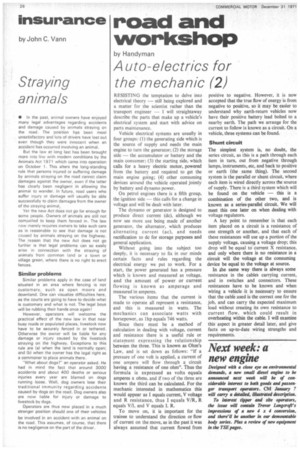insurance
Page 28

If you've noticed an error in this article please click here to report it so we can fix it.
by John C. Vann
Straying animals
• In the past, animal owners have enjoyed many legal advantages regarding accidents and damage caused by animals straying on the road. The position has been most unsatisfactory and lots of drovers have lost out even though they were innocent when an accident has occurred involving an animal.
But the law at long last has been brought more into line with modern conditions by the Animals Act 1971 which came into operation on October 1. This alters the long-standing rule that persons injured or suffering damage by animals straying on the road cannot claim damages against the owner, even if the latter has clearly been negligent in allowing the animal to wander. In future, road users who suffer injury or damage will usually be able successfully to claim damages from the owner of the straying animal.
Yet the new Act does not go far enough for some people. Owners of animals are still not comoelied to keep them fenced in. The law now merely requires owners to take such care as is reasonable to see that damage is not caused by animals straying on the highway. The .reason that the new Act does not go further is that legal problems can so easily arise in connection with the straying of animals from common land or a town or village green, where there is no right to erect fences.
Similar problems
Similar problems apply in the case of land situated in an area where fencing is not customary, such as open moors and downland. One can visualize difficulties here, as the courts are going to have to decide what is customary and what is not. The legal boys will be rubbing their hands once again!
However, operators will welcome the practical effect of the new law in that near busy roads or populated places, livestock now have to be securely fenced in or tethered. Otherwise the owner will be liable for any damage or injury caused by the livestock straying on the highway. Exceptions to this rule are {a} when the land is normally open; and (b) when the owner has the legal right as a commoner to place animals there.
"What about dogs?" an operator asked. He had in mind the fact that around 3000 accidents and about 400 deaths or serious injuries every year are blamed on dogs running loose. Well, dog owners lose their traditional immunity regarding accidents caused by dogs on the road. Dog owners also are now liable for injury or damage to livestock by dogs.
Operators are thus now placed in a much stronger position should one of their vehicles be involved in an accident with an animal on the road. This assumes, of course, that there is no negligence on the part of the driver.












































































